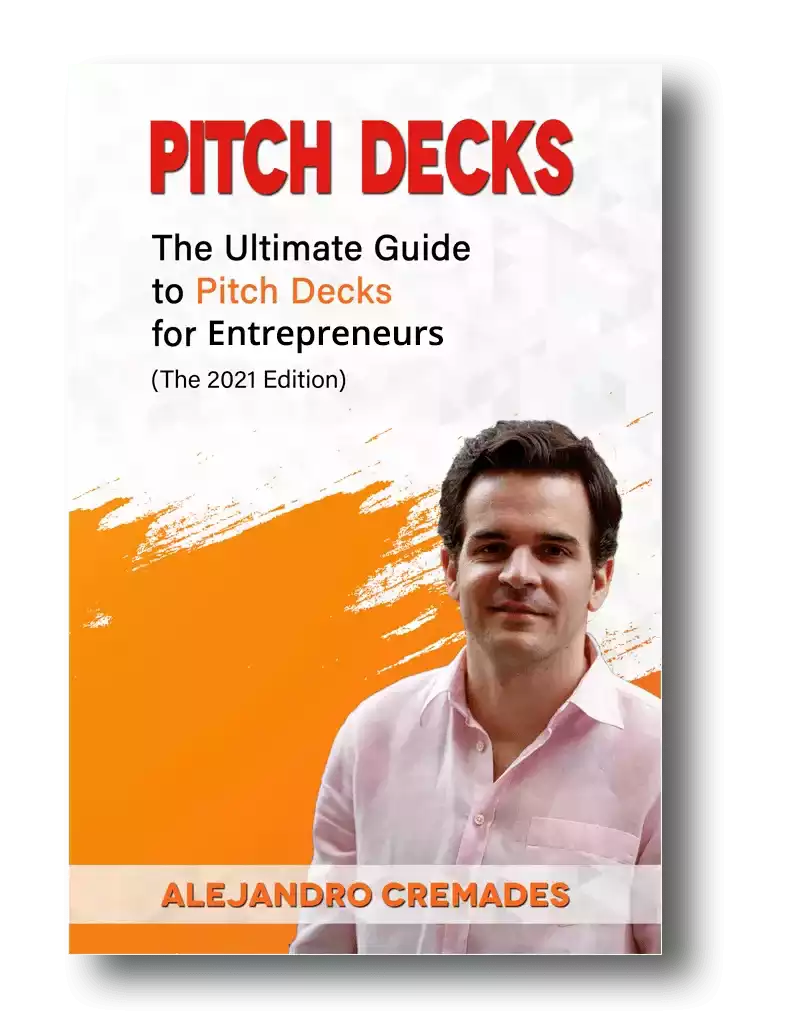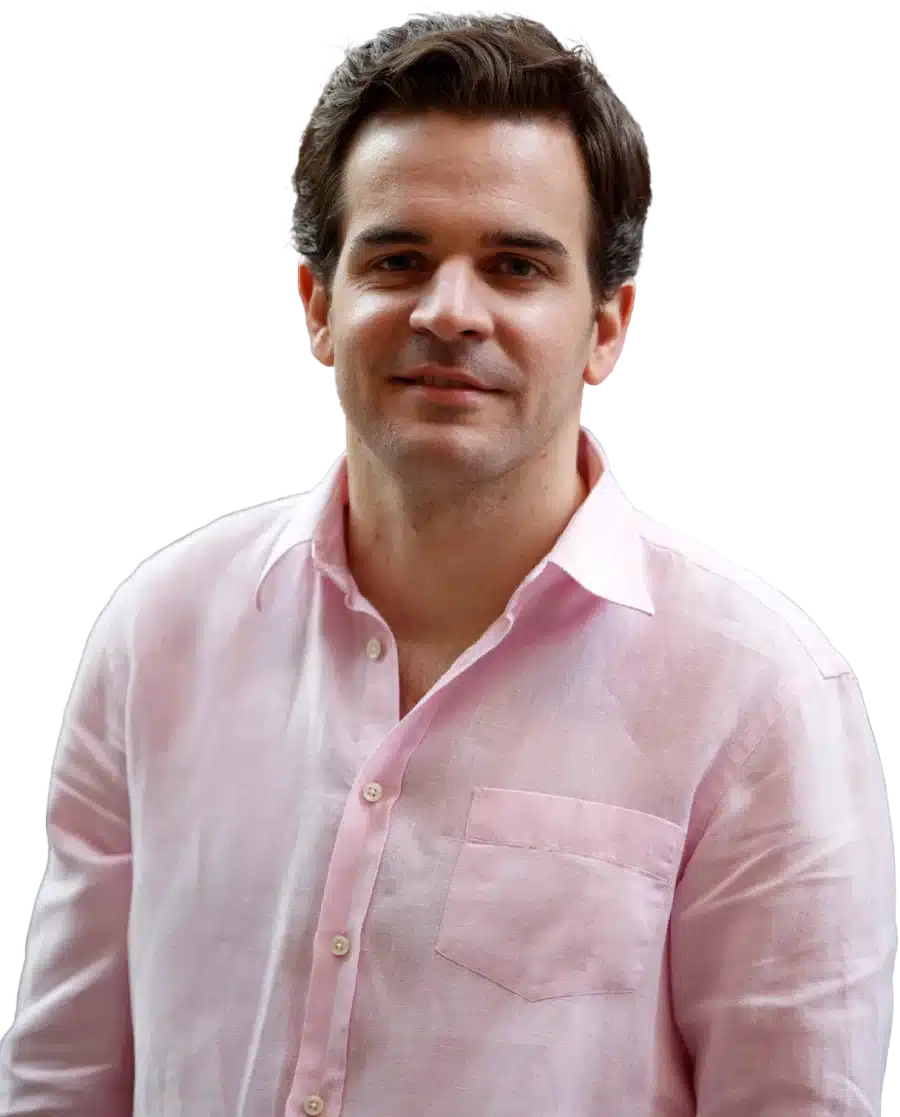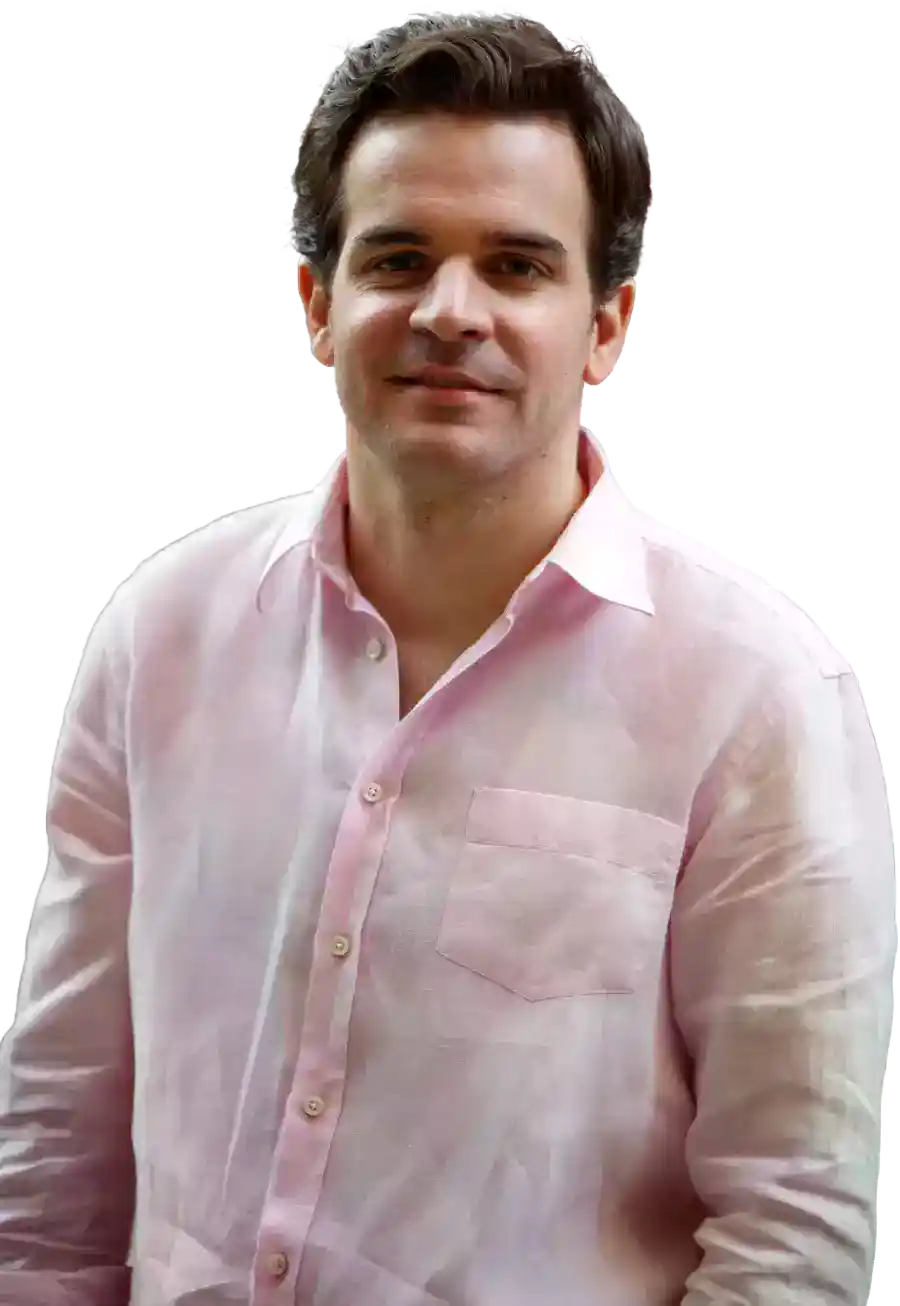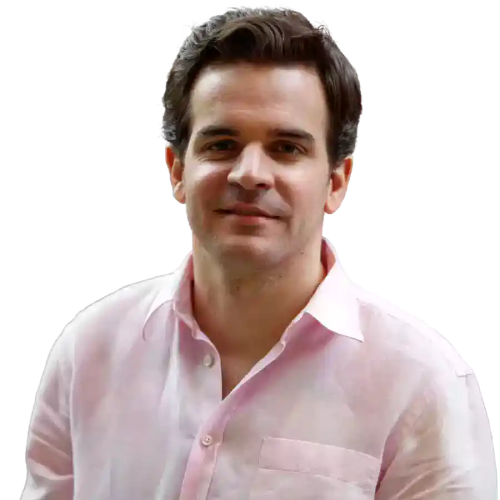Alex Hawkinson’s path as a founder reflects his incredible skills in problem-solving, curiosity, and knowing when to bootstrap and when to raise. With multiple exits under his belt, including a $200M acquisition by Samsung, he has learned to trust his instincts.
In this riveting interview, Alex discusses following his curiosity, focusing relentlessly on solving meaningful problems, and transitioning from one industry to another. His latest venture, BrightAI, may be his most ambitious yet.
BrightAI is applying artificial intelligence to the physical world’s most essential services—water, energy, and infrastructure.
Listen to the full podcast episode and review the transcript here.

*FREE DOWNLOAD*
The Ultimate Guide To Pitch Decks
Early Roots: A Swedish Legacy in the Minnesota Cold
Born and raised in Minnesota to a family of Swedish immigrants, Alex was surrounded by entrepreneurial thinking from an early age. His childhood wasn’t just about snow and school; it was filled with lessons around the dinner table.
The thesis shaped Alex’s mindset: “You don’t get a job, you make one.” That simple idea set the foundation for a career built on creating opportunities where none existed. He considers himself a “curious learner,” excited about going down rabbit holes to see where they would lead.
When Alex graduated from Carnegie Mellon, he had extensive programming experience, among other training, and the Internet was just emerging. He started building websites on the side, a skill that was not widely known at the time.
Alex entered the working world, helping businesses build websites and web applications. He launched his first startup during the early internet boom, an era when simply knowing how to build a website made one an expert.
That company was acquired as part of a larger roll-up, which coincided with the emergence of one of the world’s biggest technology enablers. This deal gave Alex his first taste of entrepreneurship and a valuable early exit.
Learning to Focus: The Apptix Years
Alex then joined Apptix, a spin-out that attempted to host desktop applications in the cloud before the term “SaaS” was coined. Despite the company’s success, Alex realized a painful but essential lesson.
Even a great team will struggle if focused on a problem that customers don’t truly care about. “You can push the boulder up the hill with a great team,” Alex says. “But if it’s the wrong hill, everything is harder.”
This experience left a mark. He learned never to underestimate the importance of picking the right problem.
Bootstrapping Wisdom at SMBLive
Armed with this lesson, Alex started SMBLive, a company focused on helping small businesses connect with customers online, which was a mission-critical endeavor rather than just email hosting.
But unlike many founders who chase VC money early, Alex made a conscious choice to bootstrap. He hadn’t yet found the pattern—that repeatable, scalable process that signals product-market fit. “Even if you can raise money, it’s a mistake to do so before finding the pattern,” he cautions.
SMBLive eventually found that pattern and was acquired by ReachLocal. The experience not only reinforced his bootstrapping philosophy but also gave him more control and a meaningful exit, even without venture capital.
The second acquisition also taught him more about the process and how to secure a good deal. As a young entrepreneur, it felt great to have liquidity and an outcome.

Raise Capital Smarter, Not Harder
- AI Investor Matching: Get instantly connected with the right investors
- Pitch & Financial Model Tools: Sharpen your story with battle-tested frameworks
- Proven Results: Founders are closing 3× faster using StartupFundraising.com
SmartThings: A Bigger Problem, a Broader Vision
The turning point came with SmartThings, which was born out of a personal catastrophe–a burst pipe in a Colorado home after a winter freeze. The irony struck Alex.
He started to think about how his smartphone could download books and stream videos, yet his home had no intelligence to prevent a physical disaster. That question led to a company that would become a leader and one of the largest platforms in the consumer IoT industry.
Alex recalls how he didn’t have any expertise in the field. However, it seemed like a really massive problem–bringing artificial intelligence into physical spaces in the world. He realized that, lacking experience in the domain, coupled with curiosity and hard work, actually gave him an edge.
Alex didn’t succumb to the groupthink that everyone else was experiencing in that space. With SmartThings, he tapped into a massive market at exactly the right time. Today, 500 million households benefit from the advantages the platform offers.
“We went from one event per day from one sensor to millions of events per second flowing through the platform,” Alex recalls. When Google acquired Nest, tech giants took notice, and soon Samsung came knocking.
Samsung acquired SmartThings in a deal reportedly worth $200M. But the bigger shift wasn’t financial, it was philosophical.
Lessons Learned from Building SmartThings
Alex took away important lessons that would form the framework for his future ventures. He developed a mantra for building businesses based on his earlier experiences of not focusing on the wrong problem.
Alex says, “It takes three to five years to build something great. Within 18 months, you’ll know if the idea has potential.” If it doesn’t click within this time frame, don’t waste time on it. It’s the wrong problem space.
Entrepreneurs make the critical mistake of developing the dimensions and parameters around an idea and building a company around it. Next, they determine the limitations and the amount of venture capital required to overcome them. Alex learned to avoid these errors.
When big tech giants like Google and Microsoft entered the space, Alex could see that SmartThings would be competing with them. He also recognized that scaling the platform was a capital-intensive project, which made it highly challenging.
Alex had the option to raise more capital or form a partnership. He chose the latter. Samsung was the biggest company he had ever worked for, with hundreds of thousands of employees. It was not only eye-opening, but also a great learning experience for him.
From Smart Homes to Smart Infrastructure: The Birth of BrightAI
Despite SmartThings’ success, Alex found himself questioning whether home automation was the most optimal use of his time. His wife, a self-described critic of his over-automated home, challenged him directly.
“She told me: these aren’t important problems. What you’re doing is interesting, but is it essential? The idea is good, but you’re focused on the wrong segment.” Alex recalls. That observation led to BrightAI, a venture aimed at tackling the truly essential systems we rely on to survive.
Alex turned his attention to the most critical problems that could be solved with technologies like IOT and AI, and bringing intelligence into these real-world environments. He began to consider developing physical AI solutions that combine hardware and software.
These solutions could revolutionize how the world manages key moving parts of the infrastructure for services such as energy (oil, gas, and electricity), water, HVAC, pest control, and food supply chain operations.
These are the sectors that civilization depends on but that are still managed, in many cases, “like the Romans.”
Business Model: AI for the Physical World
BrightAI’s thesis is bold. Use “physical AI” to bring intelligence, efficiency, and resilience to the most mission-critical parts of our infrastructure. The company blends hardware, robotics, and AI to create intelligent monitoring and maintenance systems for the modern world.
BrightAI now operates a simple yet powerful business model. It sells to large infrastructure operators who pay per AI endpoint deployed. Think–monitoring manhole covers, water systems, or power lines. Users pay per unit of robotic assessment, inspection, or maintenance work done.
This alignment with customer economics is no accident. Alex designed the model based on what would make BrightAI indispensable to those managing critical systems.
Bootstrapping to $80M Before Raising a Dime
Unlike most startups, Alex took BrightAI to an astounding $80M in revenue before raising outside capital. Asked why he waited so long, he says that he hadn’t found the pattern yet.
The product was still evolving, and Alex wanted the freedom to explore and iterate until the building blocks were crystal clear. He wanted to figure out how to create the largest possible business and make the greatest impact. His strategy was to go out and start talking to customers.
Once the pattern clicked into place in 2024, Alex made his move. He raised a $15M seed round from Upfront Ventures. The decision was rooted in precision and discipline. “I could’ve raised more. But I asked: what can I responsibly spend based on what I know?” he says.
That strategy paid off. In 2025, BrightAI closed a $51M Series A led by Khosla Ventures and Inspired Capital, bringing total funding to over $78M. The round wasn’t just about capital; it was about assembling the right partners.
“High-quality investors are worth so much to an entrepreneur,” Alex opines. This is why he chose:
- Vinod Khosla at Khosla Ventures: Known for early bets in AI, including OpenAI.
- Inspired Capital: Deep roots in commerce, infrastructure, and government, co-founded by Penny Pritzker and Alexa Von Tobel
Storytelling is everything that Alex Hawkinson was able to master. The key is capturing the essence of what you are doing in 15 to 20 slides. For a winning deck, take a look at the pitch deck template created by Peter Thiel, Silicon Valley legend (see it here) where the most critical slides are highlighted.
Remember to unlock the pitch deck template that founders worldwide are using to raise millions below.
Still Stuck in the Past
Alex draws a provocative comparison between modern infrastructure and ancient systems. Despite thousands of years of technological advancements, much of today’s critical infrastructure, including power poles, water systems, and HVAC systems, still relies on outdated practices.
Technicians are still dispatched on time-based schedules, often to inspect assets and report on whether there’s a problem or not. The work is labor-intensive, dangerous, and requires years of expertise, not to mention equipment such as hard hats and protective gear.
After visiting the oil fields of West Texas, Alex gained even more empathy for the workers on the front lines of these systems. “These are brutal, repetitive, dirty, and dangerous jobs,” Alex explains. “It takes decades to become a master technician.”
However, BrightAI is changing that with what he calls “physical AI.”
What BrightAI Actually Does
BrightAI’s platform, aptly named Stateful, enables real-time awareness of the physical world through embedded sensors and edge computing.
Whether it’s detecting a leaning power pole, a failing HVAC system, or stagnating water flow, Bright’s system continuously monitors infrastructure conditions without requiring constant human intervention.
The platform also features wearable co-pilot technology, providing AI-guided assistance to field workers. This empowers less experienced technicians to perform at near-expert levels, bridging the skills gap in industries that historically take decades to master.
In cases where automation is feasible, Bright deploys robotics to perform inspections, assessments, or maintenance, thereby eliminating human exposure to hazardous environments. It’s now also possible to send a robot to fix the infrastructure.
This hybrid approach, which combines sensing, guiding, and automating, represents a significant leap forward from reactive maintenance to proactive, intelligent infrastructure management.
The Post-Roman Era Vision
Alex envisions a world where the success of BrightAI creates a new paradigm–one of abundance. A future where essential services, such as energy, water, pest control, HVAC, run cleanly, efficiently, and sustainably. Humanity has access to the services it needs for civilization to thrive.
Instead of causing wildfires and blackouts, energy becomes consistently reliable and safe. Economic losses worth $150B from power outages in the US every year are eliminated. Instead of pollution and toxic runoff, water is appropriately treated and distributed wisely.
HVAC systems, which account for a massive share of household energy use, operate longer, consume less, and require fewer capital expenditures.
In food production, surgical pest control eliminates the need for widespread pesticide use, thus enhancing safety and reducing environmental damage.
“It’s not exactly a Star Trek future,” Alex says, “but it’s one where the fundamental needs of civilization are met in a modern, intelligent, and sustainable way.”
Alex is doing it not with flashy consumer tech, but by tackling the unsexy, often overlooked problems that make civilization itself possible. In his world, that’s precisely where the real opportunity lies.
The Teacher Who Sparked a Lifelong Journey
When asked about someone who profoundly influenced his life, Alex names John Kozer, his high school physics, astronomy, and space teacher. Kozer’s infectious curiosity and love for learning left a lasting impact.
Kozer taught a self-designed astronomy course that took students beyond the classroom, literally lying on the grass to observe the night sky. His passion inspired Alex’s curiosity, which became a defining trait in his entrepreneurial journey.
It even led Alex to become chairman of a space infrastructure company, a result of the seeds Kozer had planted. Kozer inspired him and ignited a yearning to give back to the world in some way.
Advice to His Younger Self
If he could offer advice to a younger version of himself, Alex wouldn’t mince words: “Work on the most important problem you can imagine.” It’s a counterintuitive insight. Big problems seem harder, but are often easier to solve in practice.
That’s because the best talent and capital are drawn to big, meaningful challenges. Solving real problems attracts the right people, accelerates experience, and compounds impact.
“Everything compounds,” Alex reflects. “If I’d internalized that lesson earlier and just turned that one knob, I think it would’ve 10x’d my progress.”
Closing Thoughts: The Power of Patterns and Patience
Alex Hawkinson’s journey began in snowy Minnesota and led to Silicon Valley boardrooms, from bootstrapped exits to platform-scale plays in critical infrastructure.
He has stayed true to a philosophy built on intellectual curiosity, respect for the problem space, and the patience to find the pattern before scaling.
BrightAI may be his most impactful venture yet, not because it’s the flashiest, but because it could literally keep the lights on and water flowing for generations to come.
Listen to the full podcast episode to know more, including:
- Alex Hawkinson’s entrepreneurial success is rooted in deep curiosity, problem-first thinking, and disciplined timing around fundraising.
- After multiple exits, including a $200M acquisition by Samsung, Alex launched BrightAI to bring AI-driven intelligence to global infrastructure.
- BrightAI blends hardware, robotics, and AI to modernize essential systems like water, energy, and HVAC, moving from reactive to proactive infrastructure management.
- Hawkinson bootstrapped BrightAI to $80M in revenue before raising $75M, emphasizing the importance of discovering a repeatable pattern before scaling.
- His philosophy: If an idea doesn’t show real potential in 18 months, it’s likely the wrong problem to pursue.
- BrightAI’s “physical AI” enables real-time monitoring and robotic maintenance, improving efficiency, safety, and sustainability in mission-critical sectors.
- Alex believes real opportunity lies in solving unglamorous but vital problems and that working on the most significant issues attracts the best talent and capital.
SUBSCRIBE ON:
Keep in mind that storytelling is everything in fundraising. In this regard, for a winning pitch deck to help you, take a look at the template created by Peter Thiel, the Silicon Valley legend (see it here), which I recently covered. Thiel was the first angel investor in Facebook with a $500K check that turned into more than $1 billion in cash.

*FREE DOWNLOAD*
The Ultimate Guide To Pitch Decks
Remember to unlock for free the pitch deck template that founders worldwide are using to raise millions below.





Facebook Comments